In this 5-minute read:
- How much do local bars make on St. Patrick’s Day?
- Will COVID-19 impact St. Patrick’s Day celebrations?
- Is St. Paddy’s huge across ALL bars and lounges?
- Which U.S. states see the biggest bump for St. Patrick’s Day?
St. Patrick, patron saint of Ireland, died on March 17 in the year 461, after helping establish Christianity in the region and founding many schools, monasteries, and churches. He also—if you can find a suitably inebriated reveler to spin you an apocryphal yarn or two—drove all the snakes out of Ireland into the sea, wielding a shamrock-powered light saber in one hand and a giant Solo cup of green-dyed Harp lager in the other.
Attract more happy customers with reputation management software. Learn more, plus get free reputation monitoring and customer insights when you sign up for Womply Free!
Regardless of the fact that (until the past few decades) all pubs were closed by Irish law during the holiday, we Americans tend to go our own way, and have celebrated St. Patrick’s Day since before we were a nation, often by tying one on at our local bar.
(Speaking of going our own way, did you know the iconic dish corned beef and cabbage is a Jewish/Irish-American innovation?)
To find out how big St. Paddy’s is for local bars and lounges, Womply’s data scientists examined daily revenue at 3,100 local bars and lounges across the country. Let’s take a look and see where the holiday moves the needle, and by how much. You might find some surprises!
St. Patrick’s Day at ALL bars and lounges vs. pubs and taverns
Before we get into the nitty-gritty, we need to define what kinds of bars and lounges we’re looking at here. Initially, we examined all “bars and lounges.” This included your typical St. Paddy’s Day hot spots (pubs, taverns, etc.), but it also included nightclubs, cocktail bars, lounges, and other types of drinking establishments less associated with the holiday.
Looking at all bars and lounges, we saw that St. Patrick’s Day was indeed big, but not as big as we expected.
For example, while the Saturday before St. Paddy’s (which fell on Sunday last year) was the top day of the year, Saint Patrick’s Day itself only ranked as the 44th-biggest day of the year (though it was the biggest Sunday).
So we refined our subcategory selection to “bars, pubs, and taverns,” giving us a much more accurate look at how this holiday might impact your favorite local watering hole. Let’s get to it!
How does St. Patrick’s Day compare to an average day at America’s bars, pubs, and taverns?
For bars generally, weekends are prime moneymakers anyway, and when a “drinking holiday” like St. Paddy’s falls on a weekend as it did last year, it’s the perfect storm. First, Let’s see how the average day at U.S. bars, taverns, and pubs compares to St. Patrick’s day.
The average day and average week
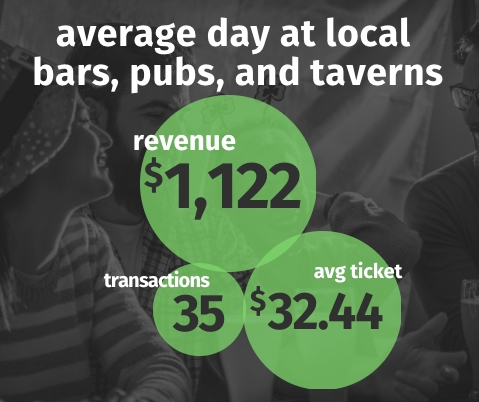
On an average day, the typical establishment in our sample earned $1,122 in revenue, processing 35 transactions at an average ticket size of $32.44.
When we look at a typical week, we see that Saturday is by far the biggest day of the week for transactions and revenue. Sundays are a little busier than Fridays (more transactions), though they both bring in about the same percentage of weekly revenue.
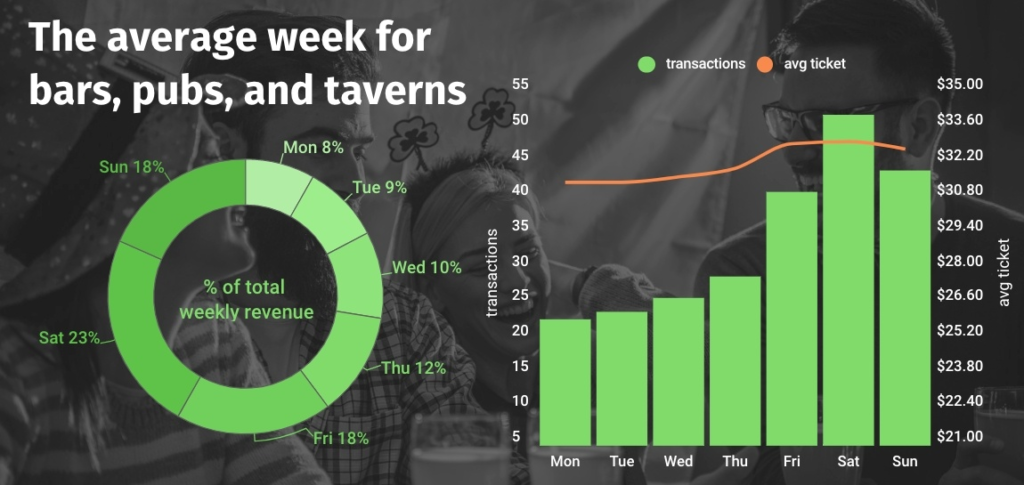
St. Patrick’s Day was the #1 Sunday of the entire year
On St. Patrick’s Day (Sunday last year), U.S. bars, taverns, and pubs in our study averaged $2,140 in revenue—48% more than their typical Sunday and a whopping 90% more than their average day throughout the year. Begorrah!
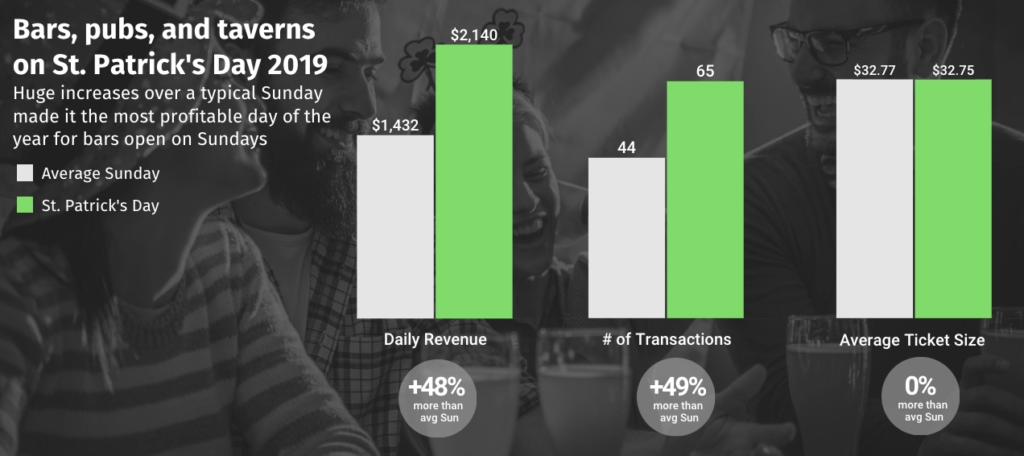
As you can see from the chart above, not only was average daily revenue up by nearly 50% compared to an average Sunday (and remember, weekends are already bigger than the average day for bars and lounges), but it’s clear that this increase is due to a greater number of patrons and transactions, rather than a larger ticket size.
Typically, on this type of holiday, average ticket size actually drops a bit (due to promotional deals). But last year it stayed almost flat, so if there were any St. Paddy’s Day sales on cheap pitchers or other drink specials, thirsty revelers drank enough overall to make up for it.
The Saturday before St. Patrick’s was the biggest day of the year overall
So we’ve seen that St. Paddy’s, the top Sunday all year, was indeed impressive compared to an average day, but the Saturday before (3/16) performed even better, taking the prize for the biggest day of the year for revenue at bars, pubs, and taverns nationally.
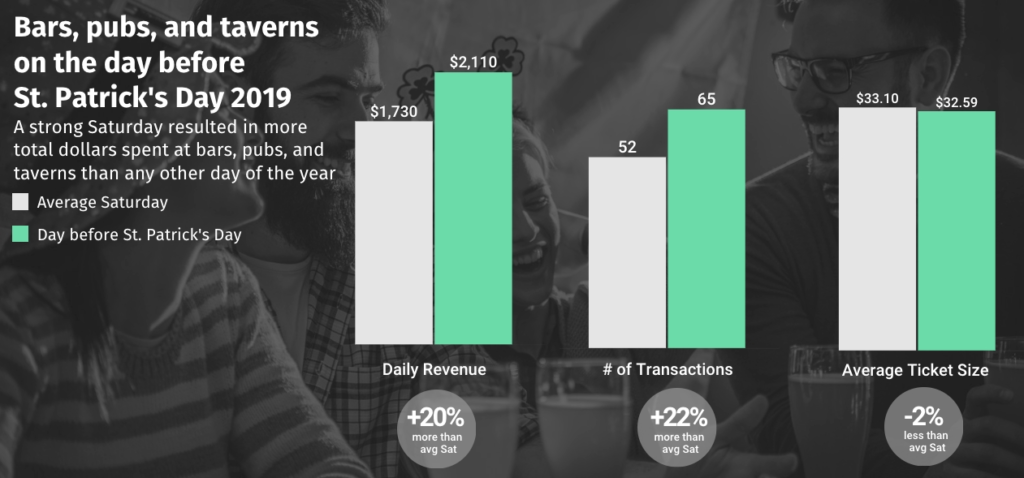
On Saturday, total revenue averaged $2,110 from 65 transactions, a 20% bump in revenue and 22% more transactions than a typical Saturday.
Remember, Saturdays are already the top day of the week for local bars, so while the increases compared to average aren’t as impressive compared to those on St. Paddy’s Sunday, total revenue and transactions were significantly greater on Saturday.
Careful observers might wonder why Saturday 3/16 ranks as the top day of the year overall if Sunday 3/17 shows a slightly higher average daily revenue number ($2,140 on Sunday vs. $2,110 on Saturday). This is because there were around 4% fewer establishments that stayed open on Sunday, so while there was more money spent total on 3/16 because there were more bars open, that money was spread more thin than it was on St. Patrick’s Day.
Top 5 days of the year for revenue at taverns, bars, and pubs
Since St. Paddy’s Saturday was the biggest day of the year for revenue at bars, pubs, and taverns nationally, we wondered what were the other top days of the year, and what the top days for ticket price and transactions were. Let’s take a look:
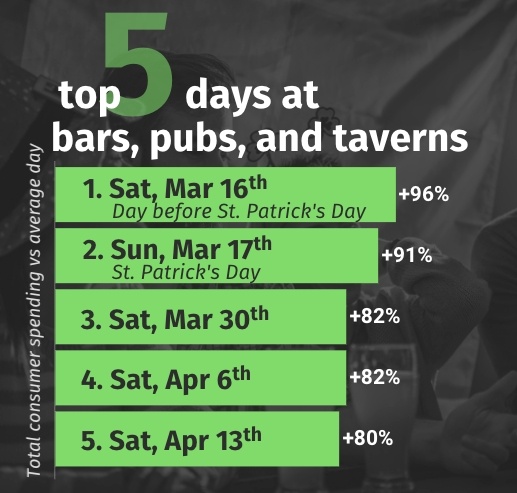
Remember how we explained that Saturday is THE day of the week for local bars? Nearly all of the top 5 days of the year for total consumer spending fell on a Saturday—with St. Patrick’s Day itself being the sole exception.
Also, as we briefly mentioned above, while St. Patrick’s Day (Sunday) was huge at taverns, pubs, and bars, it was only the 44th-biggest day of the year overall if we include all other types of drinking establishments such as nightclubs, lounges, cocktail bars, etc. in our sample.
So, we see that St. Paddy’s (Saturday and Sunday) was tops for total consumer spending. Let’s take a closer look at which days are the busiest—meaning the most transactions—and when patrons spent the most per transaction.
Top 5 days of the year for transactions and ticket price
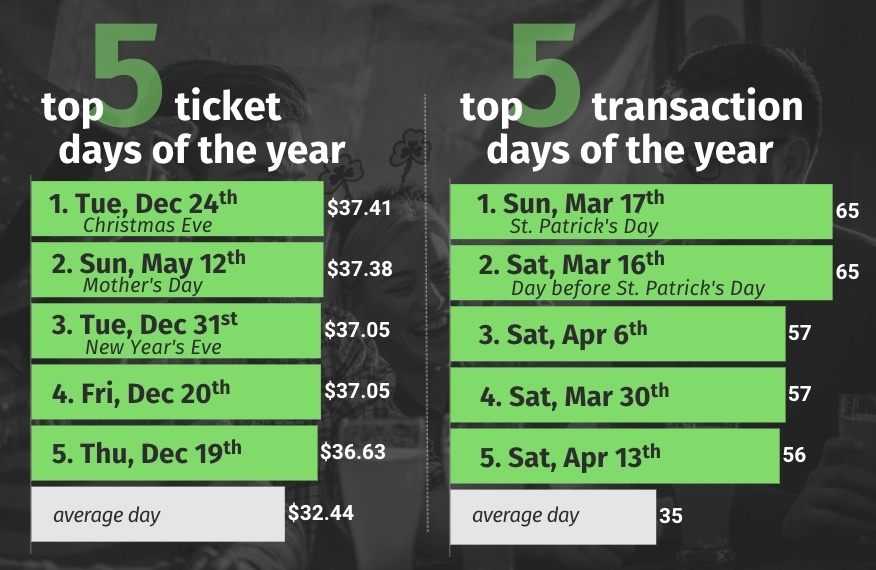
As you can see from this chart, St. Patrick’s Day, March 17th, and Saturday, March 16th, were the #1 and #2 days of the year nationally for bars, pubs, and taverns when looking at average daily transactions.
This means these establishments were busier (processing the most transactions) on these days than any other day all year. But as noted earlier, the average ticket price for St. Paddy’s Saturday was around 2% smaller than average, and Sunday’s tickets were nearly the same size as on a typical Sunday. So the huge increases in revenue detailed above were due to a much greater number of patrons.
As far as the top days for highest average ticket price, St. Paddy’s is not even in the running. 4 of the top 5 days of the year were in December, with Mother’s Day (#2) being the sole outlier.
We speculate that these larger ticket sizes may be the result of larger groups of family or friends meeting for the holiday season at “higher-end” establishments, or this data may also be influenced by a smaller number of bars and lounges being open and transacting on those days.
Seasonality at U.S. bars, pubs, and taverns by week: St. Patrick’s is the top week all year
Next let’s look at when the typical taverns, pubs, and bars in our sample earn the most revenue throughout the year.
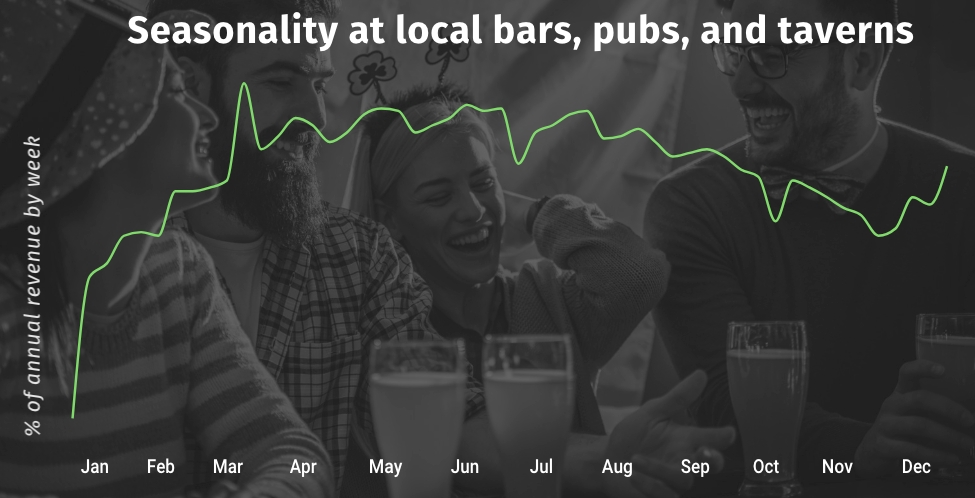
As we wrote recently, January is painfully slow for U.S. bars and lounges, as people return to work after the long holiday season and perhaps try to drink a little less as part of their New Year’s resolutions.
There’s a steady increase in revenue throughout February, and a healthy spike the week of St. Patrick’s day, easily making it the top week of the year.
In which states is St. Patrick’s Day a top-ten day of the year for revenue?
Based on its stellar showing on the national daily and weekly average charts, you might be surprised to hear that St. Patrick’s Day itself was a top-ten day of the year for revenue at bars, pubs, and taverns in only 18 states: Alaska (day rank: 1), Arizona (1), California (1), Colorado (1), Kentucky (1), Michigan (1), New Jersey (1), Texas (1), Wisconsin (1), Idaho (2), Illinois (2), Ohio (2), Utah (2), North Carolina (3), Minnesota (4), Florida (5), West Virginia (5), and Alabama (6).
However, as we discussed above, Sundays usually don’t perform as well as Saturdays, regardless of the holiday, so the fact that St. Paddy’s Sunday was a top-ten day of the year in these states is kind of a big deal.
If we look at Saturday (the day before St. Patrick’s day last year), it ranks as a top-10 day of the year in 28 states: Iowa (day rank: 1), Illinois (1), New York (1), Ohio (1), South Carolina (1), Alaska (2), Kansas (2), Kentucky (2), Michigan (2), Minnesota (2), Montana (2), North Carolina (2), Nebraska (2), Colorado (3), Idaho (3), Indiana (3), Maryland (3), New Jersey (4), Maine (5), Texas (5), Georgia (6), Missouri (6), Arizona (7), Pennsylvania (7), Wyoming (7), Rhode Island (8), Massachusetts (10), and Utah (10).
In which states is St. Patrick’s Day itself kind of… meh?
So we can see St. Paddy’s weekend was huge in more than half of the 50 states, but where is it not such a big deal?
St. Patrick’s Day is not the worst day of the year in any state (not even close), but here are the 10 states where March 17 brought in the least revenue for bars, pubs, and taverns in our sample: Oklahoma (day rank 185), Louisiana (177), Vermont (168), Delaware (149), Arkansas (133), Mississippi (126), New Hampshire (111), South Dakota (101), Connecticut (95), and South Carolina (95).
We find it interesting that South Carolina ranks among the 10 states where St. Patrick’s Day itself brought in the least revenue, when the Saturday before ranked as the top day of the year for bars, pubs, and taverns in the Palmetto State. We can only surmise that locals prefer to get their St. Paddy’s celebrating done on Saturday.
What about “big St. Paddy’s towns” like Boston, New York, and Chicago?
St. Patrick’s Day weekend in Chicago, IL
Chicago is famed far and wide for its huge St. Patrick’s Day parade and celebrations throughout the city, including (since 1962) dyeing the Chicago River green for the day.
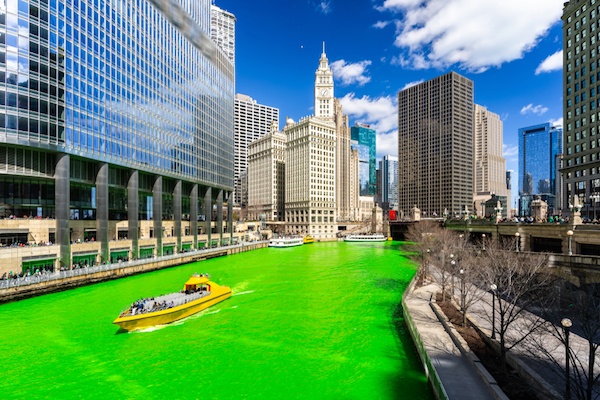
Chicago-area bars, pubs, and taverns represented the city well for the holiday weekend, with Saturday, March 16 coming in as the top day of the year, and the #1 Saturday, bringing in 167% more revenue than average. St. Paddy’s Day itself was the top Sunday of the year, and the #2 day all year for total revenue.
St. Patrick’s Day weekend in Boston, MA
Boston is a huge St. Paddy’s town, with the traditionally large Irish-heritage population, and the fact that the first St. Patrick’s day “parade” (more of a gathering) in America was held in Boston in 1737 (see below for New York’s counterpoint on that).
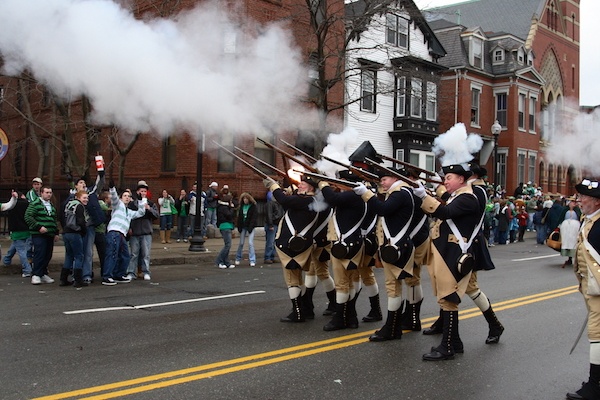
Boston-area taverns, pubs, and bars enjoyed their biggest day of the year on Saturday, March 16, and St. Paddy’s Day Sunday came in as the #3 day for the entire year, earning 122% more than average. How do you like them apples?
However, due to the coronavirus/COVID-19 situation this year, Boston’s mayor has announced that they’re canceling Boston’s St. Patrick’s Day parade this year in an abundance of caution. So far, New York and Chicago haven’t made similar decisions.
St. Patrick’s Day weekend in New York, NY
New Yorkers and Bostonians disagree on many points, and not just Red Sox vs. Yankees. Boston claims to have started the tradition of the St. Paddy’s Day parade, and naturally New Yorkers disagree, saying Boston’s “gathering” doesn’t really count, and that the first Saint Patrick’s Day parade in America was in New York city in 1763.
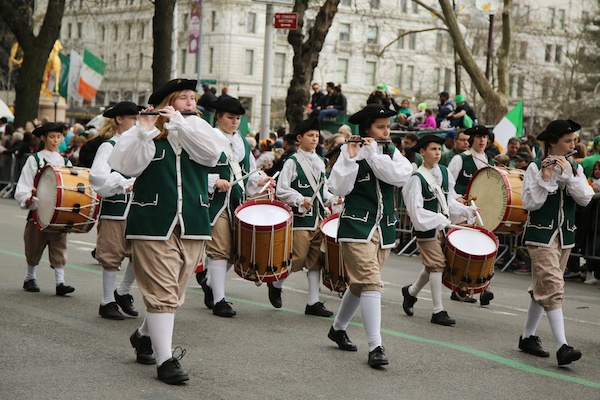
(Incidentally, residents of St. Augustine, FL say they have uncovered evidence that they beat Boston and New York to the punch by over 100 years and held their first St. Patrick’s Day parade in 1601!)
“Irregahdless,” New York-area taverns, bars, and pubs celebrated their way to their top Sunday of the year on St. Patrick’s Day, bringing in more than double their typical revenue, and earning that day the #5 spot all year. The Saturday before was their third-biggest day of the year, also earning them over 100% more than usual.
The weekend factor, COVID-19 uncertainty, and 2020 St. Patrick’s Day expectations
We mentioned the factor of the “perfect storm” when St. Patrick’s Day falls on a weekend day in a given year (which are the top revenue days of the week for bars and lounges anyway). In 2018 this was the case, so that St. Paddy’s Saturday got a pretty good bump.
Last year, March 17th was on a Sunday, and though it was the busiest day of the year as far as transactions for the bars, taverns, and pubs in our sample, the Saturday before still outperformed it as far as total revenue.
When St. Patrick’s day falls on, say, a Tuesday, as it will this year (thanks to leap year), we often see that St. Patrick’s Day itself doesn’t perform as well as it does when it falls on a weekend. But, the weekend days closest (before or after) to a midweek St. Paddy’s usually enjoy a significant revenue lift compared to a typical weekend. So all is not lost.
In a “normal year,” it would be a pretty safe bet that St. Patrick’s Day 2020 would not be the biggest day of the year. That honor would likely go to the Saturday before, though New Year’s might give it a run for its money. But St. Paddy’s would almost certainly be the number-one Tuesday in a normal year.
However, due to the worldwide uncertainty related to the coronavirus/COVID-19 scare, particularly about the potential hazards of public gatherings and physical contact (with others, door handles, bar surfaces, drinking glasses, public restrooms, etc.), it’s impossible to predict what impact this health crisis will have on revenue at these establishments, or whether COVID-19 might result in a particularly slow St. Paddy’s Day this year.
We’ll be sure to examine the annual revenue trends and let you know next year!